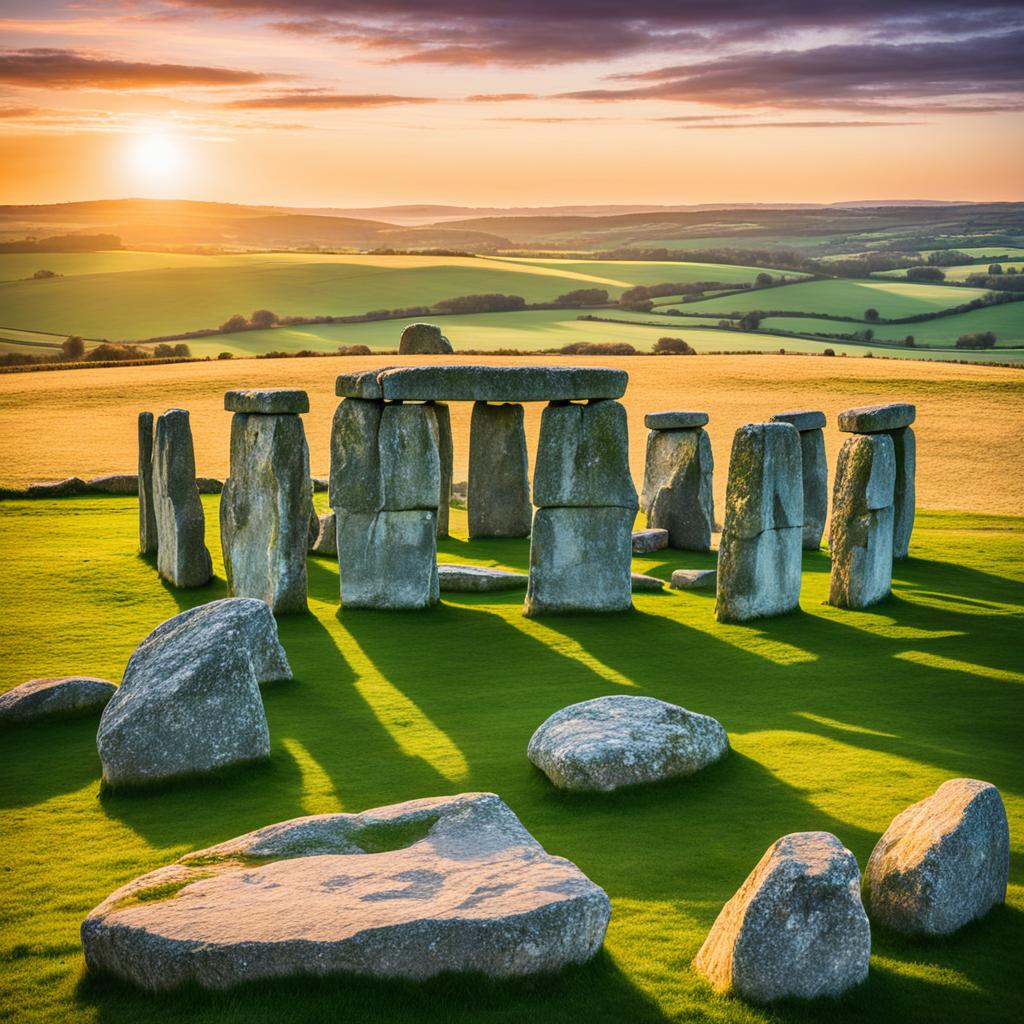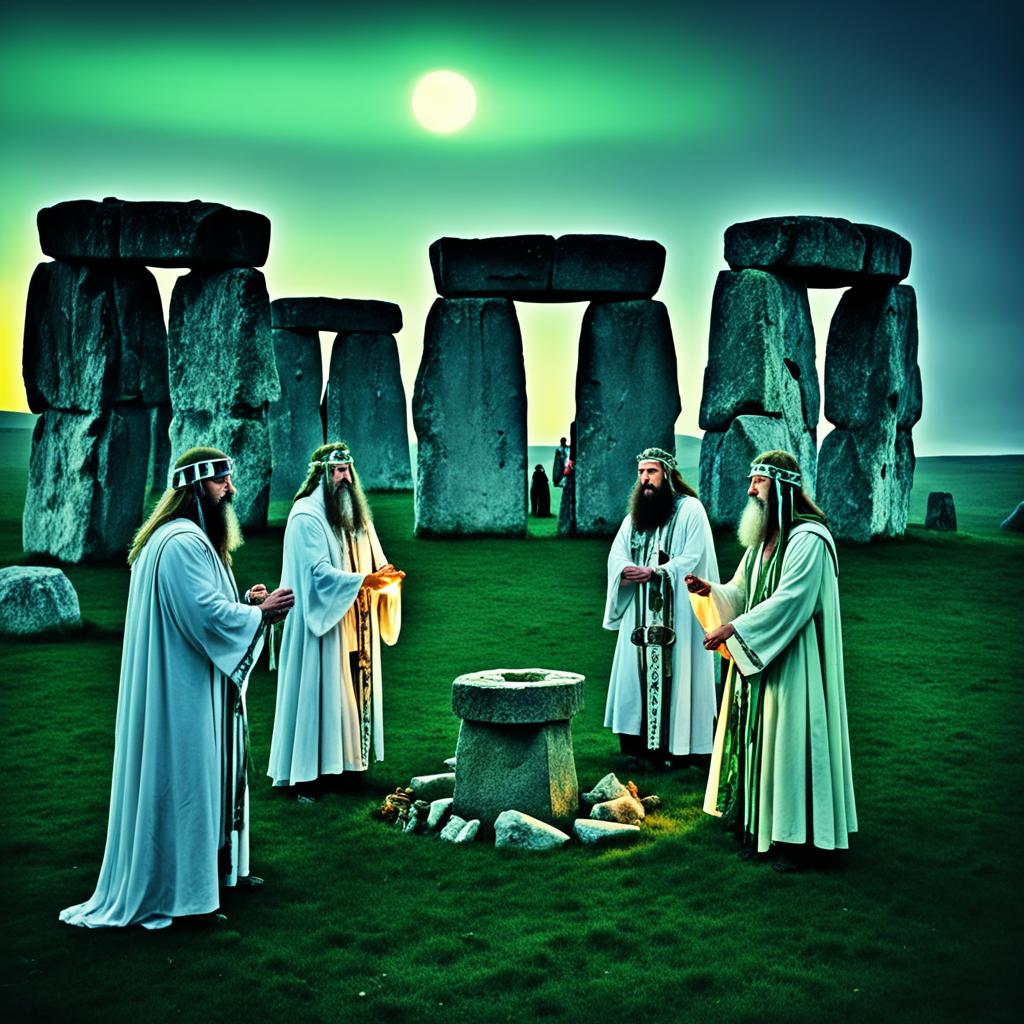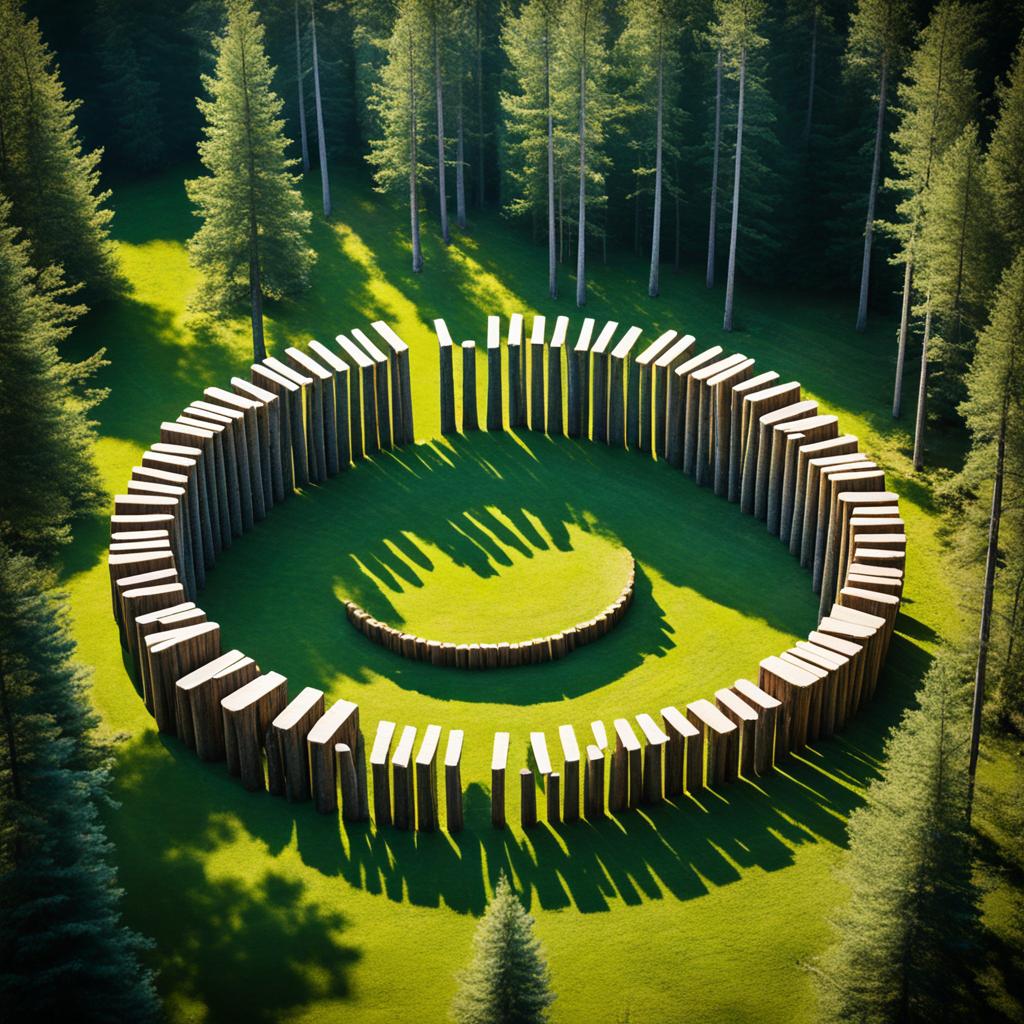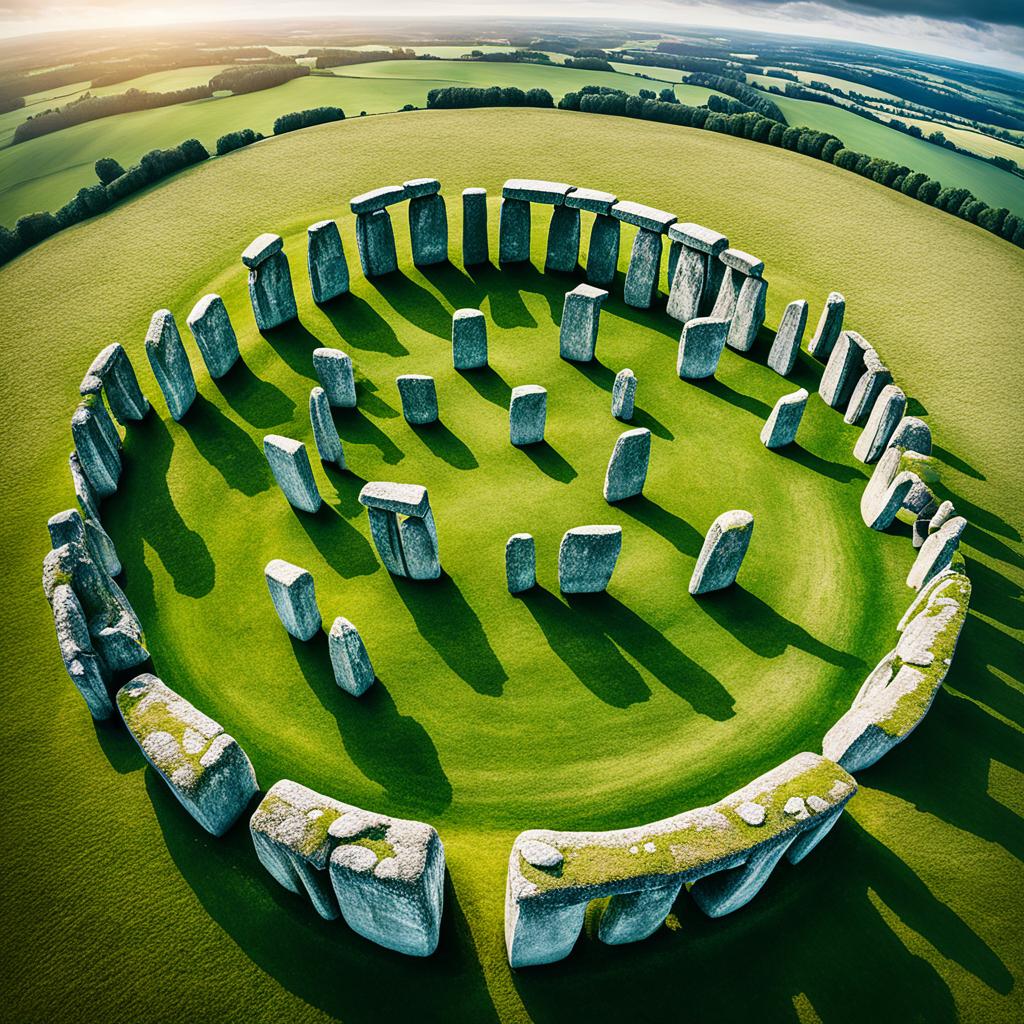Welcome to Stonehenge, an ancient marvel that has amazed everyone for 5,000 years. It stands in the English countryside, inviting us to wonder about its past. This mysterious site stops archaeologists, historians, and anyone who visits. They all ask the same questions: why was it built and what did it mean long ago?
Join us in exploring the secrets of Stonehenge. We’ll learn about its construction, its purpose, and its connection to the Druids. Let’s discover the hidden stories behind this iconic landmark.
A Brief History of Stonehenge
Stonehenge is an ancient monument in England. It dates back over 800 years, from 3100 BC to 1600 BC. It consists mainly of two types of stones: large Sarsens in an outer circle and smaller Bluestones in the middle.
The purpose of Stonehenge has long been debated. Many think it was used for both astronomy and ceremonies. Its stones seem to mark the sun’s path, suggesting it was a kind of ancient calendar.


“Stonehenge is the enduring symbol of ancient engineering and the mysteries of prehistoric civilizations.”
Stonehenge reflects the incredible genius and spiritual beliefs of ancient people. Archaeologists learn a lot about England’s ancient inhabitants by studying this site. It offers insights into their daily lives and views on the world.
The Construction of Stonehenge
Stonehenge is a mystery wrapped in wonder. It shows the amazing skills of ancient people. They built it without wheels or metal tools. Today, this wonder still puzzles archaeologists and awes visitors.
Imagine moving and shaping Stonehenge’s stones without modern tools. Hundreds joined forces, using basic tech and their engineering smarts. The huge Sarsen stones were set up with precise planning, a remarkable achievement.


Then, the Bluestones came all the way from Wales. They were special because of their blue-gray color. People believed they brought special sound and healing powers. Each placed Bluestone added more meaning to Stonehenge’s design.
It took hundreds of years and many people to build Stonehenge. This shows how important it was to them, spiritually and culturally. The site was a collaborative project of generations.
The Purpose and Significance of Stonehenge
Stonehenge’s purpose is still up for debate. Many think it was both for ceremonies and tracking the stars. Stones at Stonehenge line up with the sun’s moving positions. Archaeologists found over 50,000 burnt bones there, hinting it might have been a burial place.
It’s located in England and dates back thousands of years. The stones aligning with the sun suggest ancient people used it to mark important days, like the longest and shortest days of the year.
“Stonehenge is a testament to the remarkable craftsmanship and engineering skills of our ancestors. Its purpose remains shrouded in mystery, but the alignment of the stones with celestial movements suggests an ancient fascination with the stars and the cycles of nature,” says Dr. Emily Carter, an archaeologist specializing in prehistoric sites.
By digging at Stonehenge, scientists found many burnt bones. This could mean it was a resting place for people long ago. It shows how much they valued and remembered their loved ones.
Many theories exist about what Stonehenge was for. Some think it was a special place to remember important people. Others say it was a place for the Druids, a group that focused on nature and spiritual beliefs.
“Stonehenge remains a testament to the profound connection between our ancestors and the natural world. Its purpose may forever elude us, but its enduring presence stirs curiosity and awe in all who visit,” says Dr. Mark Anderson, a historian specializing in ancient monuments.
Stonehenge’s true meaning is still a mystery. Its value today is as a cultural and historic symbol that fascinates us. It represents ancient people’s creativity and connection with the world.
Stonehenge and the Druids
Stonehenge is an ancient monument in England. It has a special link with the Druids. They were priests or healers in ancient times. Today, Druids meet at Stonehenge to celebrate the summer and winter solstices. These events mark key moments in the agricultural year. They also symbolize the cycle of life, death, and rebirth.
During these gatherings, the Druids hold rituals, prayers, and ceremonies. They do this as the sun rises or sets over the stones. Their spiritual practice includes drumming, chanting, and offering food and drink. These celebrations show the lasting traditions and the respect for nature that have carried on for centuries.


Stonehenge’s design highlights its connection to the solstices. It seems it was built to mark these cosmic events. The link to the Druids adds more mystery and interest. Their ongoing celebrations honor the ancient ways and ceremonies once held at Stonehenge.
Woodhenge: Stonehenge’s Mysterious Sibling
Stonehenge is the world’s best-known ancient site, but it has a lesser-known sibling nearby. This sibling is called Woodhenge. It is made of timber and shares key features with Stonehenge, including its alignment and purpose.


Woodhenge was likely used as an observatory to watch the sky and for special ceremonies. It shows how prehistoric people understood the movements of the stars and planets. Their knowledge of these celestial events was very detailed.
At Woodhenge, archaeologists found human bones and special objects that suggest rituals and ceremonies were part of the site. This tells us about the connections ancient people saw between life, death, and spirituality. It also shows their deep respect for nature.
The Stones of Stonehenge
Stonehenge is an ancient site full of mystery. It’s made up of different stones that have a deep historical and symbolic meaning. This place shows us impressive ancient creativity and engineering.
Its outer ring has huge Sarsen stones, some as heavy as 25 tons. These stones were put together very carefully to form a circle. They stand there strong, making a sacred boundary around Stonehenge. On top, flat lintel stones lay across them, adding to its lasting beauty.
Going inside, you’ll see the Bluestones in a special arrangement. They’re not as big as the Sarsen stones but are very important. They make an inner circle called the sanctuary. People still wonder how they moved the Bluestones from Wales to here.
The center of Stonehenge holds the Trilithons, a striking sight to see. They are made of two upright stones with a stone across the top. It’s amazing how these heavy structures stand without falling. They show off the incredible skills of the ancient builders.
Standing apart, there’s the Heel Stone. It’s set in a way that marks the sunrise during summer solstice. This stone connects Stonehenge with the sun’s movements. It’s a clear sign of the ancient people’s respect for the natural world.
Stonehenge also has the Station Stones at its edge. They might have been used for watching the stars or for special ceremonies. And there’s the Slaughter Stone, a big mystery. No one knows for sure what it was for, adding to the place’s intrigue.
“Stonehenge’s stones are proof of human talent and the lasting power of ancient buildings.” – Archaeologist [Name]


- Sarsen stones: Form the outer ring.
- Lintel stones: Support the Sarsen stones.
- Bluestones: Create a double arc within the outer ring.
- Trilithons: Composed of two vertical stones and a horizontal lintel at the center.
- Heel Stone: Marks the sunrise during the summer solstice.
- Station Stones: Positioned along the perimeter, potentially for astronomical observation or ceremonies.
- Slaughter Stone: Adds mystery and intrigue to the ancient monument.
Stonehenge continues to attract people, sparking wonder about its builders. It’s a powerful reminder of the ancient world and the amazing things they achieved.
Stonehenge’s Hidden Treasures
Stonehenge is an ancient monument in England. It’s filled with artifacts and symbols that tell us its rich history. These finds show that many cultures and civilizations visited this mysterious place.
“Bronze Age carvings found at Stonehenge show it was used for special rituals. People believed in the power of the stars and had ceremonies for the dead. The carvings are a window into their spiritual world, from thousands of years ago.”
Roman items found at Stonehenge show its lasting importance across the years. They give us proof that Stonehenge has always been seen as special by different people.
The stones at Stonehenge were placed with great care. They are still amazing to see. Each stone adds to the mystery and beauty of the site. Stonehenge continues to awe everyone who visits.
Exploring Stonehenge’s secret treasures helps us understand its cultural importance. From the Bronze Age to Roman times, these artifacts show the site’s many meanings. They help us see Stonehenge in the ancient world’s eyes.
Preserving Stonehenge’s Legacy
Stonehenge’s restoration is key to keeping this ancient site alive. Efforts to save it and studying it carry on. Cecil Chubb stands as a key player in keeping Stonehenge alive.
In 1918, at an auction, Cecil Chubb bought the grounds Stonehenge sits on. He saw its cultural and historical value. Chubb then made a choice that changed everything. He gifted the land to his nation, making sure it’s protected for the future.
The efforts to keep Stonehenge are ongoing. Engineers work to keep the stones standing. They fight against the weather and wear. This work is to keep the site as it was while allowing safe visits.
Stonehenge means a lot to the people and tells a story of ancient times. It shows what humans from long ago could do. People from all over visit to see this wonder of history.
Saving and fixing Stonehenge helps us learn about our past. Protecting this special place means our kids’ kids can see and respect it too.
Conclusion
Stonehenge is an ancient monument full of mystery. It continues to interest people worldwide with its unknown past. The construction, use, and meaning of this site are still a big question for experts and visitors alike.
This site is more than just old rocks. It shows the creativity and skills of our ancient relatives. Stonehenge makes us think about our rich past and the mysteries of long ago.
Many aspects of Stonehenge are still puzzling. Why it was built and by whom are hard questions to answer. Its design and size are amazing, leading to many theories. The site is captivating, both in its size and in the thoughts it triggers.
Research into Stonehenge keeps uncovering new facts. It remains a beacon, calling people to come and learn about our history. The site shows our ongoing desire for knowledge and our lasting wonder about ancient times.
